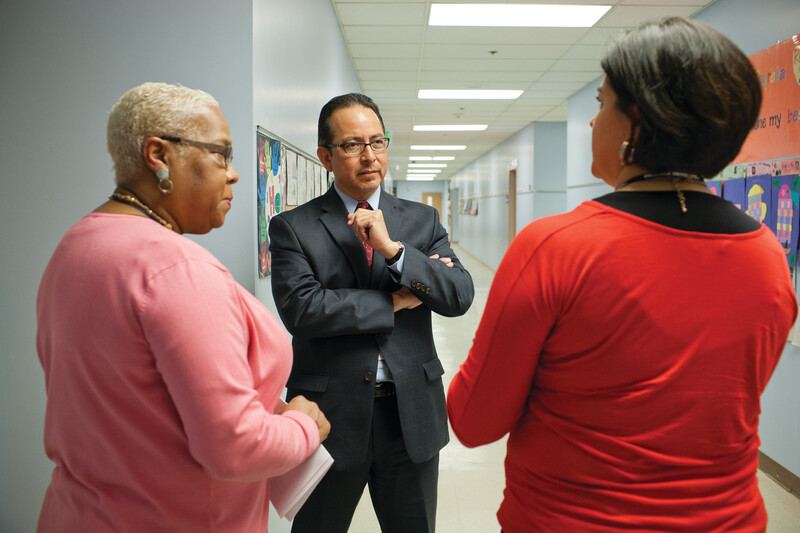Recently, a colleague told me about a principal whose school she made a point to visit any time she could. She said she always learned something when she went there. This principal was the best exemplar she'd ever seen of leadership that engenders a positive school culture.
I asked her what he did. Without hesitation, she responded, "He found a place in the hallways through which almost every person in the school passes during the course of a typical day. He makes it a priority to stand at that spot whenever people are moving about. This allows him to connect with nearly everyone every day."
The image was intriguing. I could see the danger of this principal being seen as a sort of "Big Brother," monitoring the actions of the building's inhabitants. Clearly, however, my colleague experienced his presence quite differently—as did the educators, parents, and students in the school.
Five Kinds of Leadership
Far from being a human surveillance camera, this principal was practicing a particular and potent variety of leadership. Thomas Sergiovanni (1999) describes five forces of leadership: technical, human, educational, symbolic, and cultural. In terms of school leadership, an administrator whose style is mainly technical would manage the building well. A leader focused on human leadership would manage people and human resources effectively. An educational leader would have especially sound knowledge of the practice and science of education.
The remaining two leadership forces—which I'm sure were the focus of the principal my colleague admired—are especially powerful. The symbolic leader focuses others' efforts on what is of greatest importance to the school, such as making it a place where everyone feels heard and valued, or emphasizing deep learning for everyone every day. The cultural leader focuses on building a community, and ultimately a culture, around whatever matters most.
Sergiovanni makes an intriguing point: The greater the presence of symbolic and cultural leadership, the less the other three leadership forces matter. That's not to say that symbolic and cultural leadership negate the need for a school that runs efficiently or the need for intelligent deployment of human capacity. Rather, symbolic and cultural leadership subsume the other "forces" in many ways and draw people's attention to more compelling concerns.
Leading By Vision
The principal who stood in the hallway was creating an opportunity to act as a symbolic and cultural leader. By seeing colleagues and students daily, creating opportunities to initiate conversations that helped him understand their concerns and communicate his own vision for the school, he was living out five key beliefs:
- Compelling school leaders are driven by a vision of important work. Such leadership is not about buses and bathrooms or test scores and order. It's about making kids' lives and prospects more promising. Standing at that strategic spot gave this administrator an opportunity to see students in ways that enhanced his determination to serve them well.
- To lead is to invite others to build young lives. The principal helped develop shared commitments by being available daily—and by asking questions that kept the focus on the values he hoped teachers would share, acknowledging things teachers did that strengthened the school, and just being interested in teachers' lives.
- Before individuals are willing to dedicate their efforts to a vision, the visionary must prove that vision to be compelling—and prove himself or herself trustworthy. Being present and accessible builds trust.
- Before individuals are able to contribute significantly to the vision, someone must help them develop the knowledge, attitudes, insights, and skills they need to make a real contribution. Knowing how to facilitate this growth in a broad array of individuals requires a diagnostician who seeks to understand each person's strengths, and who helps each person learn from both his or her individual work and the work of the group (Sergiovanni, 1999).
- Schools are communities of learners. Every learner in the school can improve his or her practice—or even reinvent himself or herself. The leader is the chief learner.
A Steady Presence
This "cultural leader" was a steady presence in the lives of those who traveled the halls around him, providing a smile, an affirmation, an encouragement. His predictable figure in the arterial flow of the school day indicated how much he valued the learners in that community.
Of course, he did many other consequential things—in classrooms; in conversations with teachers, parents, and students; and in leadership-sharing activities—to become a symbolic and cultural leader. But his hallway-standing habit stuck with my colleague because it reflected a leader who understood that his effectiveness derived from his ability to know and be known by those he sought to lead—to trust and be trusted.
It's interesting how many parallels there are between the approach of the principal in the hallway and that of teachers who seek not so much to manage their students as to create a culture in which every member is dignified by his or her contribution to a shared classroom community.



